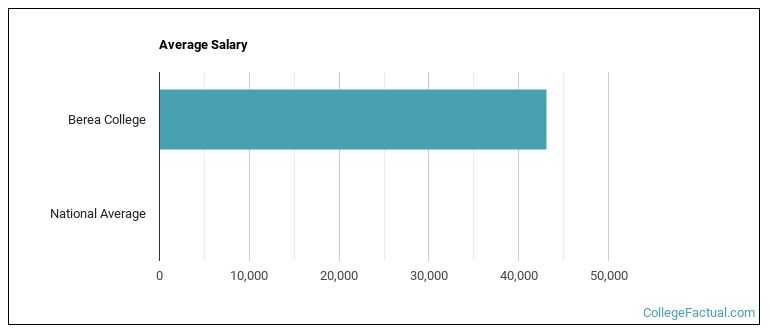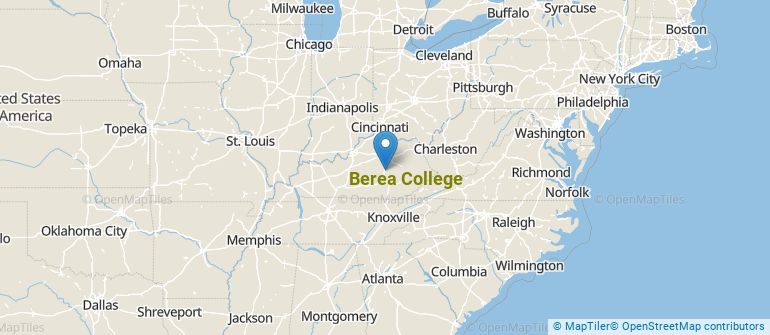 by our College Data Analytics Team
by our College Data Analytics TeamExplore the best ranked schools for the programs you are most interested in.
Berea was not ranked in College Factual's Best Overall Colleges report this year. This may be because not enough data was available.
Even if you have the best grades and high test scores, that may not be enough to get into Berea since the school has one of the most selective in the country. Its acceptance rate is a mere 25%, so there's no shame if you don't get in. Be sure to apply to other schools just in case.
About 8% of students accepted to Berea submitted their SAT scores. When looking at the 25th through the 75th percentile, SAT Evidence-Based Reading and Writing scores ranged between 578 and 673. Math scores were between 558 and 625.
The student to faculty ratio at Berea is an impressive 8 to 1. That's quite good when you compare it to the national average of 15 to 1. This is a good sign that students at the school will have more opportunities for one-on-one interactions with their professors.
Another measure that is often used to estimate how much access students will have to their professors is how many faculty members are full-time. The idea here is that part-time faculty tend to spend less time on campus, so they may not be as available to students as full-timers.
The full-time faculty percentage at Berea College is 81%. This is higher than the national average of 47%.
The freshmen retention rate of 82% tells us that most first-year, full-time students like Berea College enough to come back for another year. This is a fair bit higher than the national average of 68%. That's certainly something to check off in the good column about the school.
The on-time graduation rate for someone pursuing a bachelor's degree is typically four years. This rate at Berea for first-time, full-time students is 50%, which is better than the national average of 33.3%.
Find out more about the retention and graduation rates at Berea College.
During the 2017-2018 academic year, there were 1,432 undergraduates at Berea with 1,423 being full-time and 9 being part-time.
| $0-30 K | $30K-48K | $48-75 | $75-110K | $110K + |
|---|---|---|---|---|
| $1,677 | $2,300 | $4,627 | $2,881 | $10,396 |
The net price is calculated by adding tuition, room, board and other costs and subtracting financial aid.Note that the net price is typically less than the published for a school. For more information on the sticker price of Berea, see our tuition and fees and room and board pages.
It's not uncommon for college students to take out loans to pay for school. In fact, almost 66% of students nationwide depend at least partially on loans. At Berea, approximately 8% of students took out student loans averaging $2,559 a year. That adds up to $10,236 over four years for those students.

Get more details about the location of Berea College.

Contact details for Berea are given below.
| Contact Details | |
|---|---|
| Address: | 101 Chestnut Street, Berea, KY 40404-2182 |
| Phone: | 859-985-3000 |
| Website: | https://www.berea.edu/ |
| Most Popular Majors | Bachelor’s Degrees | Average Salary of Graduates |
|---|---|---|
| Business Administration & Management | 24 | NA |
| Computer Information Systems | 22 | $35,185 |
| General Biology | 21 | $26,744 |
| Human Development & Family Studies | 19 | NA |
| General Engineering Technology | 17 | NA |
| General Psychology | 17 | NA |
| Communication & Media Studies | 15 | $30,663 |
| Health & Physical Education | 15 | NA |
| Nursing | 14 | $67,510 |
| General English Literature | 12 | $13,403 |
This is a decrease from the 10 students who took online classes the previous year.
If you’re considering Berea College, here are some more schools you may be interested in knowing more about.
Curious on how these schools stack up against Berea? Pit them head to head with College Combat, our free interactive tool that lets you compare college on the features that matter most to you!
Footnotes
*The racial-ethnic minorities count is calculated by taking the total number of students and subtracting white students, international students, and students whose race/ethnicity was unknown. This number is then divided by the total number of students at the school to obtain the racial-ethnic minorities percentage.
References
More about our data sources and methodologies.